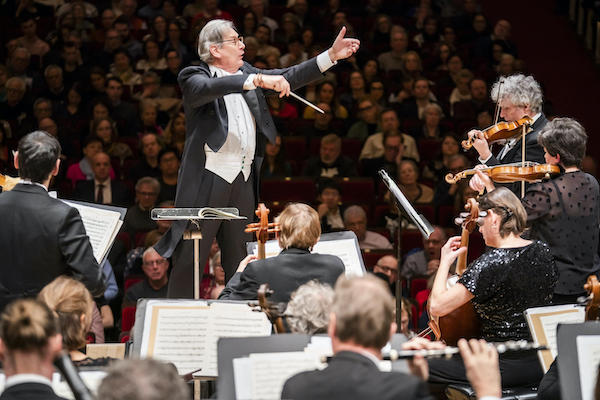Gardiner’s Second thrills, “Eroica” disappoints in Beethoven cycle at Carnegie

All of Beethoven’s symphonies are rewarding to listen to, but when an orchestra programs No. 2 and No. 3 together in one evening, as Sir John Eliot Gardiner and his Orchestre Révolutionnaire et Romantique did Thursday night in Carnegie Hall, one naturally expects some disparity of impact between the two pieces.
No. 2, after all, is considered one of Beethoven’s more conservative works, operating within the symphonic idiom of Haydn, while No. 3, the “Eroica,” is one of the most revolutionary pieces ever composed. So of course one of the performances on Thursday was more memorable than the other.
But who knew it would be the Second?
On Thursday, one of Beethoven’s “middle child” symphonies was the star, driving ahead through all of its four movements and offering glimpses, in its exciting crescendos and dissonant climaxes, of the “Eroica” master to come.
But the “Eroica” itself proved a frustrating experience, letting the listener down just when a lift was needed, and stumbling to its conclusion.
The reason in both cases: rhythm.
The prioritizing of rhythm has been one of the greatest contributions to classical performance of the period-instruments movement, in which Gardiner has played such a large role. His ensemble and others have been making the old seem new again, thanks to lucid orchestral textures and accurate, irresistible rhythms.
Which is why, following a performance of the Second Symphony that epitomized those virtues, it was so surprising and disappointing to hear a Third that suffered from rhythmic sloppiness, not just once but repeatedly.
Otherwise, the most obvious difference between these two symphonies, composed about a year apart, on Thursday was that the orchestra played the Second sitting down and the Third standing up. (Famously a historical stickler, Gardiner must have found a contemporary source that said orchestras sat in 1802 and stood in 1803.)
Musicians typically say that playing standing up makes them feel more grounded and able to put full-body energy into their performance. It didn’t appear to work in this case.
The opening measures of the “Eroica” are notoriously hard to get right. Beethoven sets the tempo with those two initial forte chords, but as often as not the conductor starts the piece over again in bar 3, in a different tempo. And more often than not, the first theme’s long-short rhythm gets blurred, so that what could be a taut, suspenseful opening to a musical drama becomes a casual stroll in the park instead.
In many performances, conductor and players overcome their initial wobbliness to give a compelling rendition of the piece. Again, not in this case.
One didn’t realize how much the Third Symphony is about long-short, long-short until one heard that rhythm sprung, over and over, through four movements. There is a kind of entropy in such rhythms that is always trying to equalize the two notes, and the player has to concentrate and count to keep the long note long enough and the short one short enough.
On Thursday, when Gardiner was conducting fast music one beat to a bar, he would give the beat and the players would subdivide it any way they wanted, which in the case of the winds was often pretty far off-rhythm. Then the music would lose its momentum and have to gather itself again, until the next stumble.
And for the funeral march to sound like a march, one has to feel the march beat ticking silently all the way through the long notes. Cutting them a little short and moving on, as happened consistently on Thursday, turns a fateful tread toward an inevitable end into merely a moody meditation.
The tick of fast staccato quarters in the Scherzo held the music together at first, but when the dynamic went from piano to fortissimo, Gardner tended to rush, spoiling Beethoven’s rhythmic jokes. The three horns in the trio, however, sounded fat, sassy, and right on the money rhythmically.
The wonderful variations of the “Eroica” finale were, like the rest of this performance, richly characterized in terms of orchestral voicing and balance—and loaded with long-short rhythms. So while the music sounded beautiful bar by bar, the air kept going out of the balloon rhythmically, so that the cumulative effect of the movement was much reduced, and the triumphal coda less impactful than it might have been.
So let us appreciate a Second Symphony whose transparent dialogue between the sections was borne along on a current of bouyant rhythm; whose lyrical Larghetto grew as steadily and organically as a daffodil in a time-lapse film; whose Scherzo was loud and soft, rough and tender, stringy and windy without deviating from its bouncy beat; and whose finale out-Haydned Haydn with its distinctive themes, one nose-tweaking and one mellow, and its teasing, start-stop coda.
The Beethoven series of Sir John Eliot Gardiner and the Orchestre Révolutionnaire et Romantique continues through Monday. They perform Symphonies Nos. 4 and 5 at 8 p.m. Friday in Carnegie Hall. carnegiehall.org; 212-247-7800.







Posted Mar 02, 2020 at 10:51 pm by Mohamed mahmoud
The beethoven orchestra is a very soft and low tempo concert. His type of music is very classical and romantic. He is considered to be one the greatest composers in the history of the music industry.